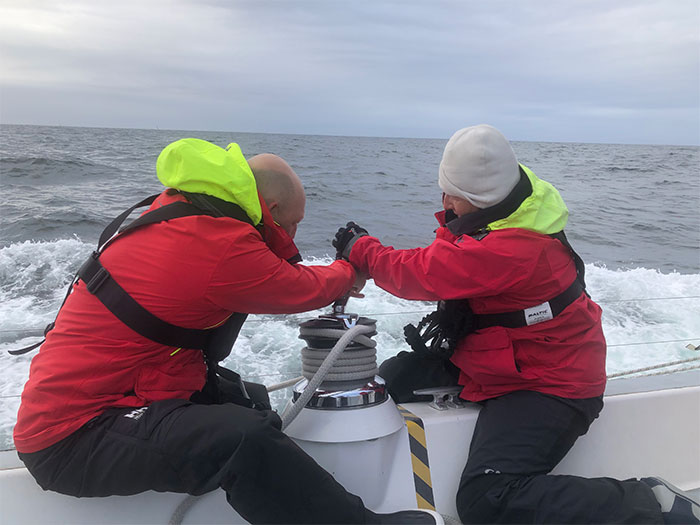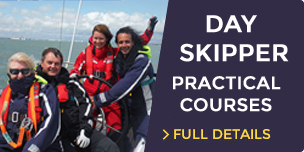Is Sailing Dangerous? (Statistics & Safety Tips)
1,200 views | March 8th, 2023One thing that often holds people back from signing up for sailing lessons is a fear of the sea and open water. Whilst it would be ridiculous for us to say there are no risks involved, the dangers of sailing are greatly reduced if you have proper training, equipment, and your own common sense.
In this guide, we will explain how dangerous sailing can be if you have not had lessons or decide to take liberties on the water. Ultimately, you can never completely avoid risk, but if you know what’s around you, build up experience with lessons, and take the right safety measures, sailing can be one of the safest sports you can partake in.
How dangerous is sailing?
Whilst the idea of sailing conjures up images of adventure and freedom, it’s important to understand the possible risks and hazards that come with the sport. There will always be dangers at sea, so it’s up to you and your crew to be prepared.
Is sailing more dangerous than driving?
However, if we can put some perspective on things, let’s look at the data first and compare to another activity such as driving.
In 2016, the RNLI released statistics showing that 10 people died in sailing accidents that year. That same year statistics showed that 131,700 people in the UK participated in sailing.
Based on this, we can calculate that of all the people sailing in the UK in 2016, 0.0076% of them lost their lives in a sailing accident.
If we then assume that every single person in the UK had also been on a car journey that year, we are able to offer a comparison on how dangerous sailing is compared to driving. In 2016, 1,792 people died in road accidents. That equates to 0.0027% of the population.
Based on our calculations, sailing appears to be more dangerous than driving in a car, but it’s still a very small percentage point of risk.
So, does this mean you should abandon your sailing dreams?
No, not at all. By understanding the risks and taking proper precautions, sailing is a hugely rewarding experience.
The next question is, how do you reduce the risks, so you don’t end up on a dangerous sailing trip.
How to reduce the dangers of sailing
1. Take classes and gain qualifications with a reputable sailing school
Sailing classes will teach you how to operate a boat, including how to handle unexpected weather conditions, navigate safely, and avoid common hazards on the water.
You can take classes and lessons which get progressively more advanced, which will help you to develop habits to make sailing less dangerous. Sailing requires a combination of technical and practical skills, including knowledge of terminology, understanding wind direction, and boat handling.
Classes can help you develop these skills.
It’s also about confidence. Sailing can be intimidating, especially for beginners. By taking beginner sailing lessons you will build confidence and have a sense of accomplishment as you learn and improve your skills.
First Class Sailing was established in 2000, and since then we have taught thousands of people to sail safely. If you would like to learn from one of the most reputable sailing schools in the UK, use our “find your level” tool to see what course would suit you best.
2. Never drink alcohol when in charge of a boat
Once you have had lessons and become qualified to sail, there’s one risk you should never take: alcohol. Statistics released by the US Coast Guard show that drinking is a factor in around 20% of all boating deaths.
The bottom line is sailing is dangerous when you drink.
Alcohol impairs judgment, slows your reaction times, and affects your coordination, and makes it more difficult to operate a boat safely. Sailing while under the influence of alcohol can lead to accidents such as collisions with other boats or objects, running aground, or falling overboard.
Alcohol also reduces the human body’s resistance to cold. If you fall in the water when drinking, hypothermia will set in more quickly.
3. Always check the weather before you set off
One of the most significant dangers of sailing is the weather. Sudden storms, high winds, and rough seas can put a boat and its crew at risk. It’s essential to keep an eye on weather reports and be prepared to adjust your plans if conditions deteriorate.
4. Always wear a lifejacket
Sailing dangers can include falling into the water or being knocked overboard. This will often cause shock and disorientation so a lifejacket, either permanent foam or gas inflated, will turn an unconscious or incapable person face up.
We run courses in personal safety including the RYA Sea Survival Course, RYA First Aid at Sea Course, and the RYA Offshore Safety Course.
5. Keep your boat well maintained
Regular maintenance of your boat helps to prevent accidents at sea caused by equipment failure. We also offer maintenance courses.
For example; the RYA Diesel Engine Maintenance Course is essential for all users of today’s boats. Students are assessed by short exercises during the course and practical work with two demonstration engines.
It’s ideally suited to both sail and powerboat users; whether you sail a yacht with an auxiliary diesel engine or are a motor cruising enthusiast, this course could not just save you money, but one day could save your life.
6. Plan your sailing trip in advance
Being prepared is one of the most important factors in making sailing less dangerous. This means planning your journey, particularly when going into waters you are not familiar with.
Study charts, anticipate possible hazards such as bridges and large vessels, or any other possible areas that could be challenging to navigate.
You could even ask locals about your travel plans before setting sail in unfamiliar waters. They can provide additional precautions and offer advice that you may not find in guidebooks or nautical charts.
Also make sure to always tell someone back on land of your sailing plans, including your destination and expected return time. This will ensure that someone knows where you are so they can raise the alarm should you not return on time.
In conclusion…
These are just a few tips on how you can reduce sailing dangers. By taking a course with First Class Sailing, you will become a competent sailor, no matter what your age. Sign up today and start learning from our experienced instructors on how to stay safe at sea.
If you want to learn how to sail, don’t let a fear of danger put you off. As we’ve shown, statistically, there is a risk when sailing, but it is small. And more so when you are well prepared and have gained RYA qualifications to let you handle any unexpected events on the water.
By staying informed about sailing safety, taking sailing classes, wearing a lifejacket, checking the weather, and maintaining your boat, you can minimize the dangers associated with sailing.
So, if you dream of setting sail and exploring the world from a different perspective, don’t let the potential dangers hold you back. Instead, take some lessons, take the necessary precautions, and enjoy the adventure of a lifetime while being mindful of your safety.
Posted by: First Class Sailing









